Sandy Shores
Coasts
- The coast is a zone that includes the shore and extends landward to the limit of penetration of marine influences.
- It might be bounded by the crest of a cliff, the head of a tidal estuary, or the solid ground that lies behind coastal dunes, lagoons, and swamps.
- The coast-line is usually taken as the margin of the land and the sea area adjoining the coast as coastal waters.
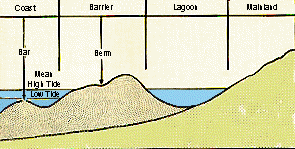
Coastal Features
- The shore is the zone between the water's edge at low tide and the landward limit of wave action.
- The backshore extends above high tide level but is inundated by exceptionally high tides or by large waves during storms.
- The foreshore is exposed at low tide and submerged at high tide.
- The shoreline is strictly the water's edge and migrates to and fro with the tide.
- The nearshore zone lies between the shoreline and the line where waves begin to break.
- The offshore zone is outside the breaker line and extends to an arbitrary limit in deep water.
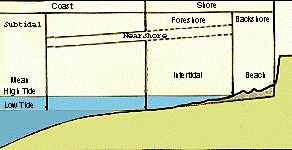
Depositional Coastal Features
- Depositional features are produced by the addition of coastal material.
- Beaches are accumulations of loose sediment, such as sand, shingle, and boulders deposited by waves and currents.
- The deposits are sometimes confined to the backshore but often extend across the foreshore as well.
- Barriers are banks of beach material that lie offshore and are exposed at high tide.
- Bars are banks of beach material that lie submerged for at least part of the tidal cycle.
- Spits are beaches that diverge from the coast and often terminate in one or more landward projections, known as recurves.
- Coastal dunes are accumulations of wind-blown sand at the back or behind the beach.
Waves
- Waves are superficial undulations of the water surface produced by winds blowing over the sea.
- Waves are energy transmitted through water with relatively little displacement of water particles in the direction of the energy flow.
- Waves consist of orbital movements of water which diminish rapidly from the surface downwards, until motion is very small.
- The dimensions of waves are determined partly by wind speed, partly by fetch (the extent of open water across which the wind is blowing), and partly by the duration of the wind.
- Storms in mid-ocean produce long, low waves that travel far beyond the storm region as a relatively regular ocean swell.
- Waves generated by wind action in coastal waters are typically shorter and less regular than ocean swell.
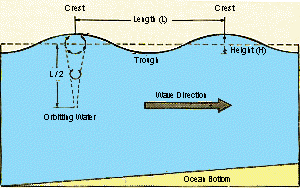
Waves in Shallow Water
- When waves move into water shallower than one half the wave length the free orbital motion of water is impeded. The frictional effects of the sea floor retard the advancing waves and they begin to 'feel bottom'. Their speed, wave length and period are all diminished.
- When the ratio of water depth to wave length falls below 0.06 the shoreward speed of the wave crest increases until it is greater than the wave speed and the wave breaks.
Nearshore Water Circulation
- Nearshore water movements associated with wave action.
- When a wave breaks its orbital motion can no longer be completed, and the unsupported wave front collapses sending forth a rush of water on to the shore, known as the swash. The swash is followed by a withdrawal, the backwash.
- Water that has been carried shoreward by wave action returns to the sea either as undertow (sheet flow near the sea bed) or in localized rip currents flowing back through the breaker line at speeds of up to 8 km/hr.
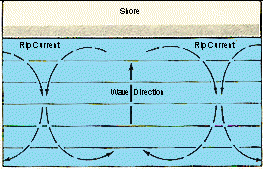
Waves and Geomorphology
- The outline in plan of many beaches is related to patterns of approaching waves.
- Sea floor topography influences the pattern of waves approaching the coast, bending (refracting) the wave crests until they are parallel to the sub-marine contours. Banks, reefs and islands hold back advancing waves while submarine troughs allow them to run on.
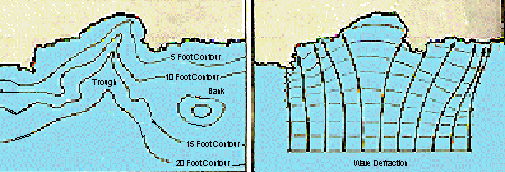
- When waves arrive at the shore on an angle they break at an angle and the pattern of swash and backwash moves water along the shore. The resulting current is called a longshore current.
- Longshore currents move sediments along the shore causing beach drifting. Sediments can be moved for miles and redeposited at great distances down the shore.
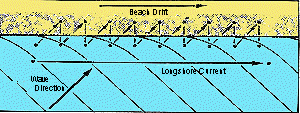
Benthic Organisms
- Benthos are organisms that live on the sea bottom or seashore
- Benthic communities are communities of organisms found on the sea bottom or seashore
Types of Benthos
- Epibenthic
- Infaunal
- Demersal
Epibenthic
- On the surface of the substrate
- Sessile=attached
- Motile=move about
Infaunal
- In the substrate
- Burrowers=dig into soft substrate
- Borers=dig into hard substrate
Demersal
- Swim near and often rest on the substrate
Types of Sandy Beaches
- Open Coast
- Barrier Islands
Physical Conditions
- Surf: High Energy
- Shifting Sands: Short and Long Term
- Tides: Periodic Exposure to Air
- Surface Temperatures: Extreme
- Organic Matter: Low
Zonation of Sandy Beach
- Extends from the subtidal to sand dunes and maritime forests
Foreshore
- Low Tide Terrace
- Beach Face
Low Tide Terrace
- Recent intertidal
- Gently Sloping
- Zone of Saturation
Beach Face
- Just above the recent high tide level
- Steeply sloping
- Spray zone
- Zone of retention
Berm
- Sand dike deposited by highest tides
- Above spray
- Zone of Drying
Backshore
- Above the berm
- Gently sloping
- Zone of dry sand
- Beach wrack deposited by highest tides
Dunes
- Foredune
- Parallel dunes
Foredune
- Just landward of backshore
- Sand from the berm is transported and deposited by wind
Parallel Dunes
- Produced on depositional coasts
- Landward of foredune
- Old, stabilized foredunes
Sandy Beach Biota
- Depauperate (low species diversity) on the beach but can be rich (high species diversity) in the dunes
- Majority of species on the beach are infaunal
- Few species on the beach are epifaunal but epifauna and epiflora can be abundant in the dunes
Biological Zones on Sandy Beaches
- Dunegrass zone
- Beach hopper zone
- Mole crab-Coquina clam zone
Dunegrass Zone
- Parallel and foredunes
- Plants: Grasses, succulents, shrubs, trees
- Plants stabilize the dunes
Fauna of Dunegrass Zone
- Insects
- Lizards & snakes
- Gulls, quail, swallows, owls & hawks
- Bats, rodents, rabbits, fox, coyote
Food Web of Dunegrass Zone
- Based on dune vegetation
- Plants eaten by herbivores & detritivores
- Supplemented by food items from the beach
Dune Succession
- Bare sand -> Grasses and succulents -> shrubs -> trees
Beach Hopper Zone
- Backshore
- No plants
- Crustaceans:
- Beach hoppers (amphipods)
- Isopods
- Ghost Crabs (in burrows during day)
Other Animals of the Beach Hopper Zone
- Sand flies (biting, no-see-ums)
- Beetles & other insects
- Gulls
- Rodents
Food webs of the Beach Hopper Zone
- Detritus based
- Beach wrack
Mole Crab-Coquina Clam Zone
- Microscopic algae
- Interstitial diatoms and dinoflagellates (interstitial=living in the spaces between sand grains)
- Phytoplankton
Microfauna of the Mole Crab-Coquina Clam Zone
- Zooplankton
- Interstitial Animals: nematodes, copepods, polychaetes, etc.
Macrofauna of the Mole Crab-Coquina Clam Zone
- Mole Crabs (Emerita)
- Coquina Clams (Donax)
- Surf Clams & Pismo Clams
- Large Polychaetes
- Calico Crabs, Moon Snails, Sandpipers
Food Web of the Mole Crab-Coquina Clam Zone
- Based on phytoplankton, interstitial algae and detritus
Trophic Structure of the Mole Crab-Coquina Clam Zone
- Filter feeders: Mole Crabs, Coquina Clams, Surf Clams & Pismo Clams
- Carnivores: Calico Crabs, Moon Snails, Sandpipers
- Scavengers: Calico Crabs
- Large Polychaetes can be filter feeders, detritivores or carnivores
|
Notes
9.1 Rocky Shores
|